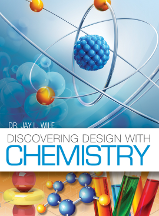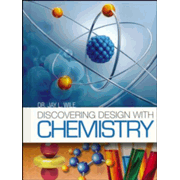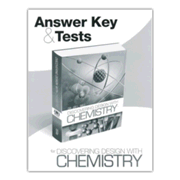Discovering Design with Chemistry is a college-prep chemistry course written directly to students so that they can work independently. They can even complete experiments on their own, although it would probably be both fun and helpful to work with a group class on the experiments.
Dr. Jay Wile writes in a relaxed, conversational style. He often poses a question and answers it, just as a teacher might do in a classroom. For example, on page 199, he writes, “How do we figure out the mass we need to get a mole of a given molecule? We just look at the Periodic Table and figure out the mass of the molecule in amu. That also tells us the number of grams it takes to have a mole. How do we figure out the mass of a molecule in amu? Remember, mass is always additive, so to figure out the mass of a molecule, you just add the masses of all the atoms in the molecule.”
Dr. Wile provides plenty of help with computations when needed. In fact, the entire first chapter is about measurements and calculations since students need to become very familiar with them if they hope to master chemistry.
The rest of the text covers standard content for high school chemistry courses, although it includes mention of religious influences in the lives of scientists and it points out instances of God’s incredible design. While religious elements are not at all heavy-handed, this text is likely to appeal most to Christians.
While the text is fairly easy to understand, there is a free course website that has links to videos from a variety of sources on particular topics that might add further explanation.
The text has 16 chapters, and it should take about two weeks to complete each chapter. A detailed schedule of weekly assignments begins on page 519. Students are encouraged to copy these pages then check off the boxes as they complete assignments. These pages can also be downloaded from the publisher’s website.
Within each chapter, colored boxes make it easy to spot the different types of material. Pink boxes have statements and equations that must be memorized. Examples based on lesson material (e.g., computations, molecular configurations, equations, etc.) are in orange boxes. “Comprehension Check” are scattered throughout each chapter in purple boxes, and experiments are in green boxes. Students should stop to read, memorize, or work through the material in each box when they come to it.
Complete solutions for Comprehension Check questions are provided near the end of each chapter to give students immediate feedback. These solutions should be very helpful if students use them appropriately after they try to answer the questions on their own. Extra practice problems are available on the publisher’s website for those who find them helpful.
Open-book chapter reviews are intended to help students do a self-check before taking the chapter test. Chapter reviews are in the textbook while tests and answer keys to both reviews and tests are in the Answer Key & Tests book.
The publisher’s website has printable pages with the Comprehension Check questions and review questions with space to write answers for each. While students can simply answer the questions from the book, these pages should help students keep their work organized and easy to review while also making it easy for parents or teachers to see questions and answers together. There is also a ready-to-print student notebook with these pages plus blank pages for students to use for their lab notebook. (Resellers sell spiral-bound student notebooks if you want to buy them already printed and bound.)
There are one or more experiments per chapter—46 in all. There are also some videos of experiments on the publisher’s website that demonstrate procedures that are either too difficult or too dangerous for students to do at home. Students will need many resources for the experiments, but most of them are household items or things easily obtained. (Lists of required materials for each chapter are at the front of the textbook.) Still, there are lab equipment items and a few chemicals such as beakers, a mass scale, and strontium chloride that are required, and these can be purchased in a kit from Nature’s Workshop Plus (http://www.workshopplus.com). For those who do not want to invest in the kit for whatever reason, Appendix C in the textbook explains how 27 of the experiments can be done without the kit. (Students would have to skip the other 19 experiments.)
Students will need to create a separate lab notebook. An explanation of how to do this is on page iv of the student text, and four sample pages showing what students might write for their labs are available on the publisher’s website. Many experiments require calculations, and the text has sample calculations for the pertinent experiments on pages just before chapter reviews.
Summary
The layout of Discovering Design with Chemistry makes it very easy for students to simply follow along through the lessons. They don’t need to figure out which experiments to do from a separate lab manual since everything is included exactly where it will need to be used. The design of the text along with all of the student support materials (i.e., complete solutions, sample calculations, extra teaching videos, additional practice problems, etc.) make this course especially user-friendly. Even better, students who register (for free) can email questions to Dr. Wile if they need help. While students should appreciate all of these features, I suspect that the fact that students can work through the course independently will be especially appealing to homeschooling parents.













